Walkin’ Wheels SMALL Dog Wheelchair
11 – 25 lbs.
Are you a Pet Care Professional?
Request an account to view pricing.
If you are an existing pet care professional, simply login.
Not a Pet Care Professional?
Learn more about Walkin' Wheels SMALL Dog Wheelchair at Walkin' Pets.
The Walkin’ Wheels Small Dog Wheelchair is designed to improve mobility for small pets with hind end weakness, mobility loss, or rear leg paralysis. The fully adjustable Walkin’ Wheels wheelchair is ideal for both long-term uses to keep dogs active and for short-term rehabilitative use.
Features:
- Ideal for small animals weighing 11 to 25 lbs.
- Push Button Adjustability
- Fully adjustable in height, length, and width
- Available in three colors: Blue, Pink and Seafoam
- Wheelchair frame made of durable, lightweight extruded aluminum
Clinical Advantages:
- Improve mobility for pets during surgical or injury recovery
- Enhance physical therapy and strength training exercises
- Wheelchair can adapt as mobility loss progresses; the front attachment can be added to convert into a full support/4-wheel cart
Fits Small Breeds such as: Miniature Poodle, Dachshunds, Maltese, Bichon Frise, Jack Russell Terrier, Miniature Schnauzer, King Charles Cavalier Spaniel, Pug, French Bulldog, Shih Tzu, Boston Terrier, Wire Fox Terrier, Miniature Pinscher, Chihuahua, and more.
A specially designed Corgi wheelchair is available here
Conditions that Benefit:
How to Integrate Cart Time into Your Hospital’s Rehabilitation Protocols
Using a wheelchair with hospitalized, down patients is ideal. Wheelchairs allow patients to stand upright instead of lying in lateral recumbency, improving recovery times. Adding five to ten-minute cart walks into a patient’s treatment plan several times daily can improve a dog’s mental health and save the technicians back.
Here are a few simple Walkin’ Wheels exercises to try:
Wheelchair Assisted Walking Exercises
Place the patient in their wheelchair to encourage walking and assist patients during rehabilitation sessions. During early sessions begin with short-timed walks and slowly increase the duration over time. Most likely, your patient has likely been inactive for an extended period, causing them to fatigue quickly. It’s recommended to keep your first cart walk between 6-10 minutes. Complete exercise 3-4 times daily based on the patient’s condition and need.
Assisted Walking with Proprioception Training During Rehab
For patients with hind limb proprioceptive deficits, place the patient into their Walkin’ Wheels and try putting a No-Knuckling Training Sock on the affected limb or limbs and begin walking. This exercise will encourage proprioception training while the patient is fully supported. Walk for 5-10 minutes, 3-4 times daily based on the patient. Session length may be increased at the therapist’s discretion.
Assisted Walking with Strength Training
Once the patient has gotten stronger but still may need moderate support for workouts, you can add leg weights to any limb that needs increased strength. It may be best only to apply one leg weight at a time, but it’s up to the therapist’s discretion how much weight and how long is appropriate based on the patient.
Rear Support Wheelchair with Therabands
Resistance Therabands may be used on the hind limbs to target specific muscle groups and attached to the struts of a patient’s Walkin’ Wheels wheelchair to add strength training to your patient’s cart walks. Place for 5-10 minutes during a walk twice daily is recommended, but times may vary based on each patient. Therabands can vary in resistance levels, so starting with a low level and increasing based on patient needs is advised.
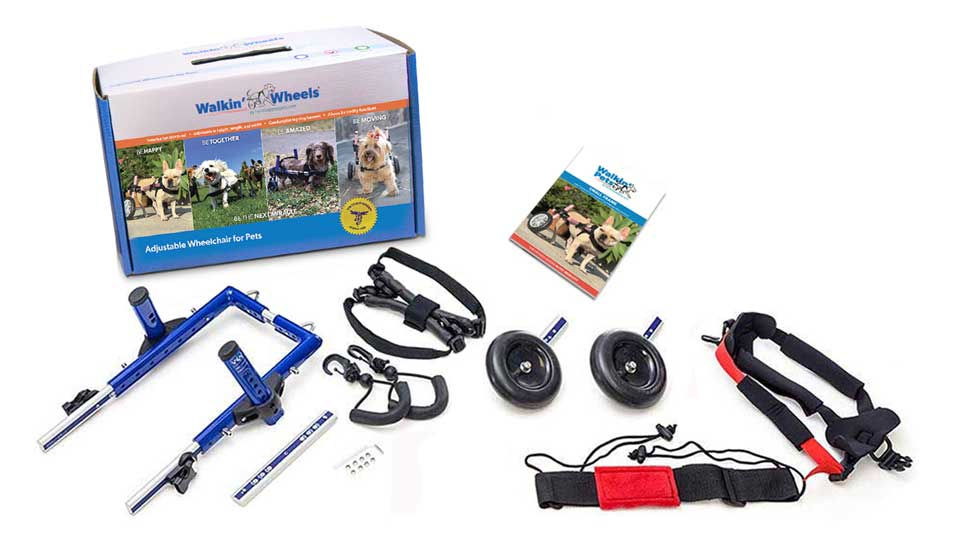
What’s In the Box?
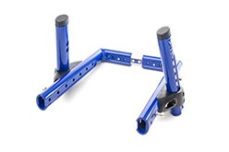
Frame:
The frame is blue, seafoam, or pink powder-coated aluminum. It will not bend, break, or rust. Black knuckles are on each side of the frame, which hold the leg of the wheelchair to the frame. The wheels/struts will be inserted into the leg and adjusted to the proper height. The knuckle has a high and low setting which can be adjusted with a Phillips screwdriver.

Width Connectors:
Your wheelchair will come with two width connectors (7″ and 4″). One is already installed in the back of your cart. If you need more width, the wheelchair comes equipped with a longer connector in the box.
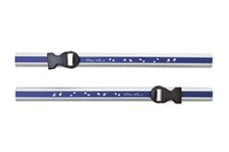
Length Extenders:
Your wheelchair will come with two extenders (side rails) installed, which determine the length of your dog. The length of the extender should end in the middle of the dog’s front leg. It should not pass the front leg.
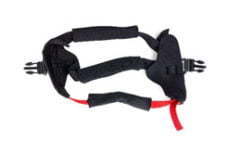
The Front Harness
The dog’s head goes between the blue and black straps. The red strap goes under the dog’s front legs and clips on the side of the harness. The shoulder pads are made of neoprene and keep the straps and buckles from causing discomfort for the dog. Neoprene comfort sleeves wrap around the straps for the dog’s comfort. Comfort sleeves can be cut in half if they are too long.
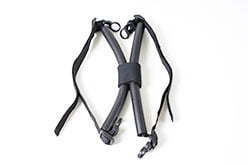
Leg Rings:
The dog’s hindquarters are held in place by the leg rings, or our rear harness support system. The leg rings can also be used as a lifting harness when out of the wheelchair; the excess strapping can be touch-fastened together to make handles on each side.
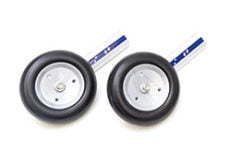
Wheels & Struts:
The wheels are attached to a metal piece called a “strut.” Four-inch foam wheels come standard, which are great for all terrains. They feature a dense foam interior with an outer rubber layer. These wheels will not puncture, wear extremely well, and are easy to clean. Eight-inch wheels are also available, depending on dog’s measurements.
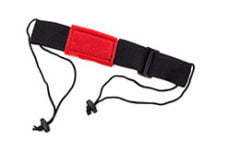
Belly Belt:
The Belly Belt will help support your dog’s back. It is not always necessary to use the belly belt, but is highly recommended for dogs with a long back, overweight or elderly dogs, dogs with curvature of the spine, and dogs with disc problems.
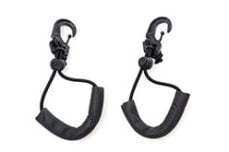
Stirrups:
Stirrups are used to hold the dog’s legs off the ground so they don’t drag due to paralysis, knuckling under, or foot injuries. The adjustable stirrups are positioned to hold the foot up at the hock. If your dog doesn’t need them, the stirrups may be removed from the wheelchair.
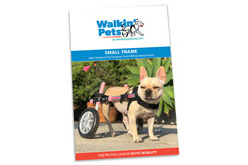
The Manual:
The manual gives instructions and tips on assembling and using the Walkin’ Wheels Wheelchair.

Tool Kit:
The tool kit comes in a plastic bag and includes and Allen wrench and set screws. The (optional) set screws may be used to tighten up the wheelchair frame and reduce flexibility, depending on your preference.
1. Measure the Rear Leg Height to the toe pad, ideally when your pet is laying down. Do not pull the leg tight; leave some natural bend.
2. Measure your pet’s length or armpit to rump (ATR).
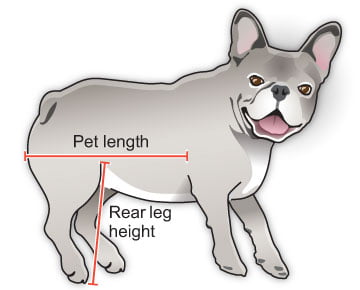
| Rear Leg Height | Weight | Pet Length (ATR) | Size |
|---|---|---|---|
| 3-6″ | 11-14 lbs | 7-15″ | Small-64 |
| 7-8″ | 11-14 lbs | 7-15″ | Small-94 |
| 9-13″ | 11-14 lbs | 7-15″ | Small-114 |
| 6-8″ | 15-25 lbs | 7-15″ | Small-68 |
| 9-11″ | 15-25 lbs | 7-15″ | Small-98 |
| 12-15″ | 15-25 lbs | 7-15″ | Small-118 |
Using our SureFit® Calculator? Enter your pet’s Rear Leg Height, Pet Length, Weight and Breed to get the perfect wheelchair configuration for your pet.
Watch How to Measure Your Pet for a Walkin’ Wheels Wheelchair!
Here are a variety of resources to help you assemble the Walkin’ Wheels, how to put a dog into it, how to adjust the wheelchair and finetune the fit, as well as getting a dog used to their new wheelchair:

Can pets pee and poop in the Walkin’ Wheels wheelchair?
Yes, the Walkin’ Wheels wheelchair is designed to help pets get the exercise they and do their business mess-free.
Can pets sit in a wheelchair?
No. Our chair is designed NEVER to collapse on the dog’s leg or spine. We’ve gone to great lengths to be sure of it. The chairs are designed with the help of veterinarians and rehabilitation specialists to hold the dog up, keeping the spine and legs in the optimal position for safety and healing.
What’s more, the purpose of the chair is to give the dog exercise and the freedom to go outside and do his business. When the dog is tired, you should never leave him in the chair.
The reviews we have seen of the experimental sit-down spring-loaded style have not been positive. Although we have done a great deal of research, we have not found a safe way for a chair to collapse on a dog.
Can pets use their Walkin’ Wheels inside the house?
Yes. The Walkin’ Wheels is designed to be used both indoors and outside. If a paralyzed pet needs an indoor mobility solution that can be worn for extended periods of time, we recommend the Walkin’ Scooter.
Can dogs lie down in the wheelchair?
For many pets using a MINI, it is okay for them to take a rest up against a pillow or bed, because their legs are so short. Otherwise, it is not recommended, due to back or disc issues that could worsen by laying down in the wheelchair.
Can pets use his/her rear legs in the wheelchair?
Absolutely. In fact, we encourage pets to use his/her rear legs. The Walkin’ Wheels can help pets maintain muscle mass, increase strength and exercise. If a pet’s rear legs are paralyzed, use stirrups to prevent their back legs from dragging.
How do I determine the correct size wheelchair for my patient?
It only takes a few simple measurements to determine the correct size wheelchair for you patient. Watch the video below to see how:
Watch How to Measure Your Pet’s Rear Leg Height Video!
Is the wheelchair easy to transport?
This wheelchair folds flat for easy transport.
Will this wheelchair rehabilitate my patient?
We have seen varying degrees of recovery with pets using the wheelchair. Some dogs’ mobility has improved so much that they no longer require a wheelchair. Every animal’s case, condition, and disabilities are unique. While a patient is in a wheelchair, they get physical therapy to improve their physical and mental health.
How do I get my patient into their Walkin’ Wheels wheelchair?
It’s very easy to get a small dog in and out of their Walkin’ Wheels dog wheelchair. First, place the front harness on the pet and put your dog on the ground with the wheelchair behind them. Lift their hind legs and place them through the leg rings before lifting the sidebars and clipping the harness to the wheelchair frame.
How do I get my dog used to their new wheelchair?
This is a great question. Over the past 20 years, we’ve determined how to best get a pet acquainted with its wheelchair. Read our article for more information.
What is your wheelchair return policy?
We intend that every Walkin’ Wheels user be happy with their wheelchair. If you experience problems, please call us. Often, we can help with a simple adjustment that will make your patient more comfortable in their new cart. If you feel the wheelchair is not for you, we can issue a Return Materials Authorization or RMA. Please read through the full return policy or contact our Veterinary Outreach Team at 1-866-578-2926.


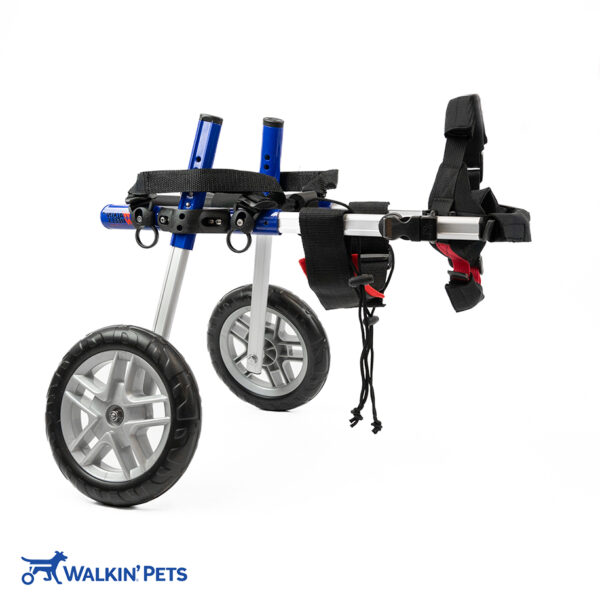
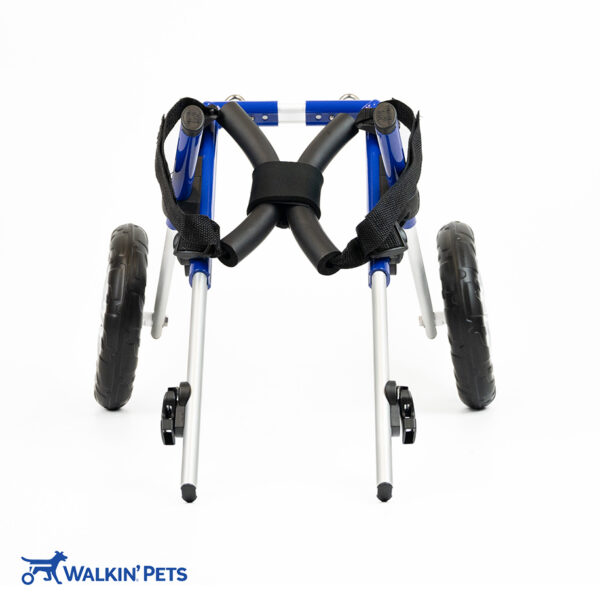
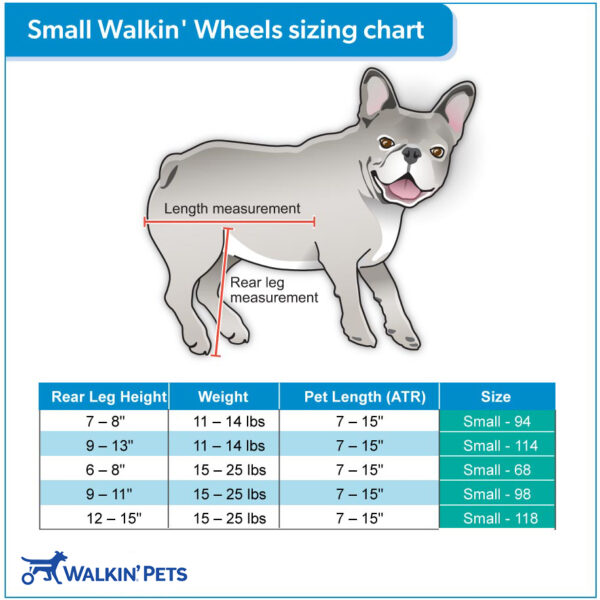
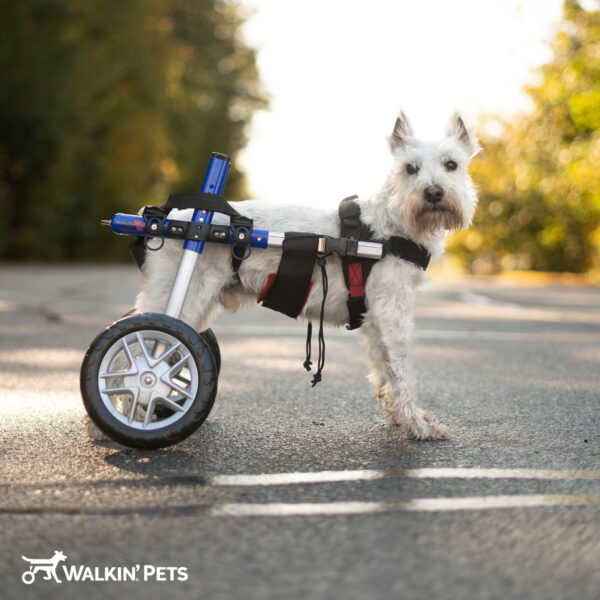

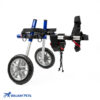
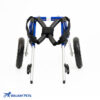
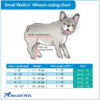


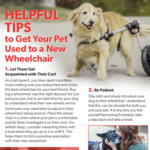
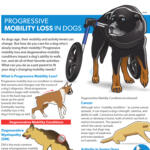
Have a question about this product?